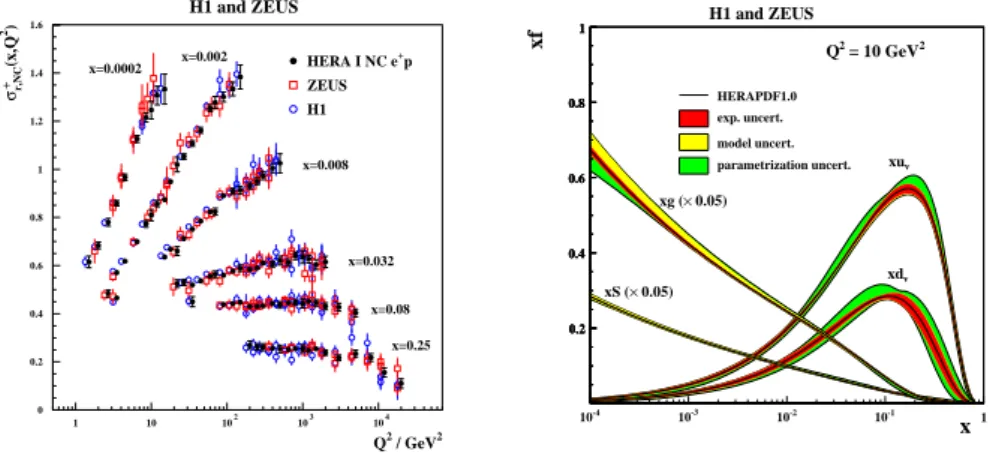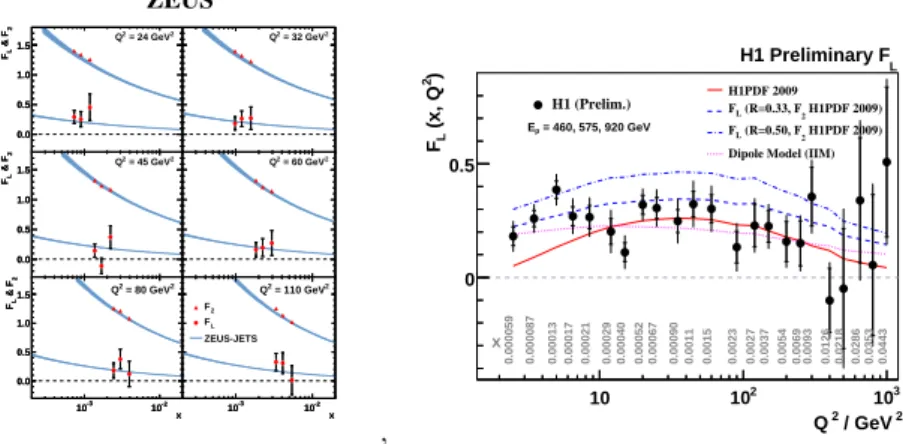PROTON STRUCTURE FUNCTION MEASUREMENTS AT HERA
V. Chekelian (Shekelyan)
aMax Planck Institute for Physics, Foehringer Ring 6, 80805 Munich, Germany
Abstract. Recent results from the electron-proton collider HERA on the structure of the proton and understanding of the data in terms of QCD are presented.1 Introduction
At the first ep collider HERA, electrons of 27.5 GeV collided with protons of 920 GeV (820 GeV until 1997). This corresponds to an ep centre of mass energy of 320 GeV. The maximum negative four-momentum-transfer squared from the lepton to the proton, Q
2, accessible with this machine was as high as 100000 GeV
2. The two ep interaction regions were instrumented with the multi- purpose detectors of the H1 and ZEUS collider experiments. Over 15 years of data taking from 1992 to 2007, these two experiments together collected a total integrated luminosity of ≈ 1f b
−1, about equally shared between positive and negative polarities and positive and negative longitudinal polarisations of the lepton beam.
This paper concentrates on recent developments related to the central topic of the HERA physics program - the measurements of the inclusive neutral current (NC) and charged current (CC) deep inelastic scattering (DIS) cross sections, determination of the proton structure and understanding of the data in terms of Quantum Chromodynamics (QCD). The ultimate goal for these measurements is to obtain one unique HERA data set, which averages the H1 and ZEUS results produced in different years with emphasis on different features of the apparatus. Recently the combination is performed for HERA I, the first phase of the HERA project from 1992 to 2000, for which both experiments completed and published final results. These combined data are analysed in the QCD framework, and the parton distribution functions (PDFs) in the proton are determined. At the end of the HERA data taking, special runs were performed with reduced energies of the proton beam of 460 and 575 GeV. Using these data the longitudinal structure function was measured in a model independent way.
2 Deep inelastic NC and CC ep scattering
The deep inelastic NC e
±p scattering cross section with unpolarised beams can be expressed in the reduced form as
˜
σ
N C±(x, Q
2) = d
2σ
±N CdxdQ
2xQ
42πα
21 Y
+= F
2(x, Q
2) ∓ Y
−Y
+xF
3(x, Q
2) − y
2Y
+F
L(x, Q
2), (1)
ae-mail: shekeln@mail.desy.de
H1 and ZEUS
Q2 / GeV2 σr,NC(x,Q2)
x=0.0002 x=0.002
x=0.008
x=0.032
x=0.08
x=0.25 HERA I NC e+p ZEUS H1 +
0 0.2 0.4 0.6 0.8 1 1.2 1.4 1.6
1 10 102 103 104
0.2 0.4 0.6 0.8 1
10-4 10-3 10-2 10-1 1
0.2 0.4 0.6 0.8 1
HERAPDF1.0 exp. uncert.
model uncert.
parametrization uncert.
x
xf 2
= 10 GeV Q2
xuv
xdv 0.05)
× xS (
0.05)
× xg (
H1 and ZEUS
0.2 0.4 0.6 0.8 1
Figure 1: Left: Selection of combined NCe+preduced cross sections from HERA I compared to the separate H1 and ZEUS data input to the averaging procedure. Right: The parton distribution functions from HERAPDF1.0, xuv, xdv, xS = 2x( ¯U+ ¯D) andxg, at Q2 = 10 GeV2. The gluon and sea distributions are scaled down by a factor 20. The experimental,
model and parametrisation uncertainties are shown separately.
where α is the fine structure constant, x is the Bjorken scaling variable, y characterises the inelasticity of the interaction and Y
±= 1 ± (1 − y
2). The NC cross section is dominated by the contribution of the proton structure function F
2(x, Q
2). At leading order in QCD, F
2is related to a linear combination of sums of the quark and anti-quark momentum distributions in the proton, and the structure function xF
3(x, Q
2) is related to a linear combination of their differences. The longitudinal structure function F
Lis equal to zero in the quark-parton model due to the spin one half nature of the quarks. Non- zero values of the longitudinal structure function appear in QCD due to gluon radiation.
The deep inelastic CC cross section can be expressed in a similar manner.
The W
±-boson exchange in the charged current process distinguishes between the charges of the constituent quarks. So, for the electron (positron) beam the cross section depends on the u(d) quark content of the proton.
3 Combination of the H1 and ZEUS inclusive data
The published H1 and ZEUS measurements on inclusive NC and CC reactions
cover a wide range of x and Q
2. For NC the kinematic range is 6 · 10
−7≤ x ≤
0.65 and 0.045 ≤ Q
2≤ 30000 GeV
2, and for CC it is 1.3 · 10
−2≤ x ≤ 0.40 and
300 ≤ Q
2≤ 30000 GeV
2. All published NC and CC cross section measurements
from H1 and ZEUS obtained using data collected in the years 1994-2000 are
ZEUS
2 & FLF
0.0 0.5 1.0 1.5
= 24 GeV2 Q2 2 & FLF
0.0 0.5 1.0 1.5
2 & FLF
0.0 0.5 1.0 1.5
= 45 GeV2 Q2 2 & FLF
0.0 0.5 1.0 1.5
x
10-3 10-2
2 & FLF
0.0 0.5 1.0 1.5
= 80 GeV2 Q2
x
10-3 10-2
2 & FLF
0.0 0.5 1.0 1.5
0.0 0.5 1.0 1.5
= 32 GeV2 Q2
0.0 0.5 1.0 1.5
0.0 0.5 1.0 1.5
= 60 GeV2 Q2
0.0 0.5 1.0 1.5
x
10-3 10-2
0.0 0.5 1.0 1.5
F2 FL ZEUS-JETS
= 110 GeV2 Q2
x
10-3 10-2
0.0 0.5 1.0 1.5
,
0 0.5
= 460, 575, 920 GeV Ep
0.000059 0.000087 0.00013 0.00017 0.00021 0.00029 0.00040 0.00052 0.00067 0.00090 0.0011 0.0015 0.0023 0.0027 0.0037 0.0054 0.0069 0.0093 0.0126 0.0218 0.0286 0.0353 0.0443
x
H1 (Prelim.) H1PDF 2009 H1PDF 2009) (R=0.33, F2 FL
H1PDF 2009) (R=0.50, F2 FL Dipole Model (IIM)
H1 Preliminary FL
/ GeV 2
Q 2
)2 (x, QLF
0 0.5
10 102 103
Figure 2: Left: F2 andFLas measured by ZEUS as a function ofxat fixed values ofQ2. Right: The H1 measurement ofFL(Q2) averaged overxat fixed values ofQ2. The resulting
x values of the averagedFLare given in the figure for each point inQ2.

